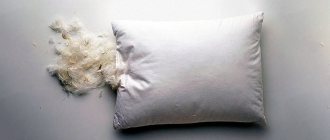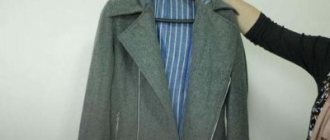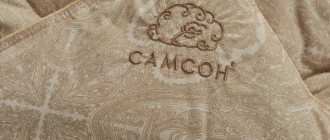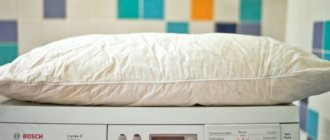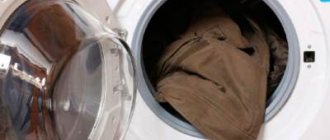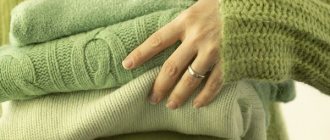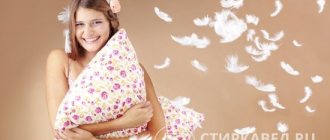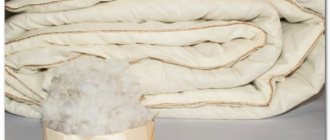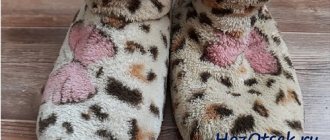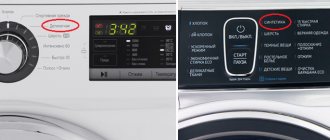Pillows are used constantly - and this cannot but affect their appearance and condition. They may change shape somewhat, dust may accumulate in them, and the cover may become stained. That is why it is important to regularly and promptly care for your bedding. Dry cleaning remains the ideal solution for them, but not everyone has the time or opportunity to systematically send the bed for special treatment. That is why the question of whether pillows can be washed in a washing machine remains relevant for many housewives. In fact, home care is possible - just choose the means and method, taking into account the composition of the model.
Is it possible to do this?
The optimal frequency for washing bedding with down and feather filling is twice a year. If you do this more often, the filler will deteriorate and its quality will deteriorate.
Before you start washing, you need to understand what kind of feather the pillow is filled with - chicken or waterfowl (duck, swan, goose).
The necessary information is contained on the product label. The composition is indicated there and recommendations for caring for bedding are given.
Attention! If the filling is a chicken feather, you should not wash the pillow. These bedding items are dry cleaned.
A distinctive feature of chicken feathers is that they strongly select moisture and take a long time to dry. The filler in a dried pillow will disintegrate into small components.
Waterfowl in Peru are not harmed by moisture. Washing such pillows is not contraindicated; the main thing is to follow certain instructions.
To clean feather-stuffed bedding, use:
- machine washable;
- hand wash;
- steam treatment.
It is important to study and strictly follow all recommendations of the pillow manufacturer.
Does a new pillow need to be washed?
There is no clear answer to this question.
- On the one hand, if the pillow is new, there is no need to wash it. Inside there is a fresh filler, outside there is a brand new cover. Preventive washing and drying will only take energy and time.
- On the other hand, before reaching the buyer, the product travels a long way. First, materials are produced in large factories, then stored in warehouses until they finally hit store shelves. At each stage, sanitary standards may be violated. For example, the chemical is not washed away. The pillow can simply fall on the floor, or be stored in a dirty room.
The housewife herself must decide whether to wash this particular new pillow or not.
Pros:
- lack of individual packaging;
- visible dirt;
- foreign odor;
- use of a pillow by a child or allergy sufferer.
"Against":
- difficult to maintain filler.
Preparing to wash at home
At the preparatory stage, the following manipulations are performed:
- Clean bedding from dust.
- Prepare bags for washing.
- Distribute the feather from the pillow into the bags.
- Knock out the pillow and place the fluff in the covers
- Dust that has accumulated during the period of use of the bedding is removed with a cracker designed for cleaning carpets.
- There is no point in using a vacuum cleaner; it is too powerful and can damage the upholstery. Reducing power will not give the desired effect.
- At the next stage, you need to sew special bags in which the filler will be placed. Washing the pillow completely is not practical.
- A dense layer of padding will not allow for quality cleaning. The fluff will turn into poorly dried, caked clumps.
It is recommended to sew 4 bags, using thick cotton fabric measuring approximately 25-30 cm. The length should be identical to the width.
Reviews from people who have washed feather pillows suggest that teak is the best option. It holds nimble fluffs and prevents small feathers from flying out of the cover during the washing process. It is not advisable to use gauze, even if it is multi-layered.
Advice! Instead of several small bags, you can use one large one, twice the length of the bedspread. If the pillow has standard dimensions, the length of the cover will be 140 cm.
The most important task is to distribute the stuffing among the bags:
- Close all doors and windows to avoid drafts.
- Lay out a sheet and place a pillow on it.
- Carefully press the napkin along the seam.
- Fill the bags with feather and sew them up carefully.
Before placing the filler in the bags, spray them with water. This will prevent the fluff from flying away.
If the condition of the pillowcase is satisfactory, shake it off, wash it and can use it again. If desired, make a new cover.
Old pillowcases can serve as laundry bags. But the fabric must be intact and dense enough.
Do you wash feather pillows by hand or in the washing machine?
By handIn the machine
Choosing funds
Washing is preceded by the choice of products.
Here it is important to remember the properties of fluff. Its structure is made up of thousands of threads that easily intertwine with each other and form a continuous tangle. It perfectly traps solid particles, so you can’t use granular washing powder. You won’t be able to get rid of small grains in the upholstery even with 3-4 rinses. This is fraught with an allergic reaction and hives.
The most suitable are considered:
- Laundry detergents that have a liquid consistency.
- Food acids.
- Oily hair shampoos.
Advice! When washing down and feather pillows in a machine, it is recommended to use balms or capsules. There are no problems with washing them out, and the structure and quality of the upholstery are not damaged.
From food acids, a bite or lemon is suitable. They do a good job of cleaning down-filled pillows. With their help it is easy to remove grease stains and dirt. But do not forget that vinegar leaves behind a long-lasting odor. Citric acid is more effective, but before use it must be dissolved in hot water.
If the listed products are not at hand, use regular shampoo. Bedding is subject to the same contaminants as hair. In this case, shampoo is as effective as balm.
Should I steam the seams or not?
- Washing should begin with steaming the seams.
- The filler is soaked in a basin or in the bathtub, and the pillowcase in the machine.
- After washing and drying the fabric, it is sewn and stuffed again.
This option is suitable for those who need not only to clean a pillow filled with feather or down, but also to restore it. After washing, the bedding will look like new.
It is not recommended to wash the entire pillow. This option is chosen by the lazy, but it has not worked well.
Important! The main thing is not to try to clean the down from dirt in the machine, placing it there separately from the pillowcase.
Even special bags will not prevent it from scattering throughout the drum. This method of washing is fraught with clogging of the filter and the nozzle that supplies water.
To prevent the pillow from “turning into a frog”
After preparing the pillows for washing, they can be loaded into an automatic machine or washed by hand. Only one pillow needs to be sent into the drum, without other things. The choice of washing and spinning modes will depend on the filler of the product. If you wash it incorrectly, instead of a neat “fluffy” pillow, you can end up with a slippery, shapeless “frog”.
Next, we’ll look at how to wash items with different fillings in a washing machine.
Synthetic and holofiber. They are sent to the car as rarely as possible - preferably no more than 2 times a year. It is recommended to select the delicate mode. Since the filler absorbs water strongly, rinse the pillow at least 2 times and wring it out at maximum speed.
Made from feathers and swan's down. The pillow is carefully ripped open, the cover and filling are washed separately. It is best to divide all the feathers into 2-3 equal parts, put them in bags, carefully sew them up or tie them tightly. Along with them, it will be useful to throw several tennis balls into the drum of the washing machine. They will not allow the fluff to form a ball.
Feathers are removed from the pillow and washed separately.
Then the water temperature in the automatic machine is set to no more than +30 ℃ and the delicate mode. But it is better to refuse automatic spinning, since it can contribute to the destruction of fluff and feathers.
After washing, you need to take the fluff out of the bags, spread it on sheets or bath towels and roll it into a tight roll. This will help squeeze out any remaining water. After drying, the down or feather is folded back into the washed diaper and sewn tightly. It is recommended to clean such pillows 2-4 times a year.
"Anti-stress" . Inside these pillows there are small balls made of polystyrene. Such products can be washed 5-7 times a year, but very carefully. Manual mode is suitable, eliminating strong push-ups.
Made from wool. For washing pillows made of camel wool or sheep wool, the “wool” and “hand wash” modes are suitable. A detergent containing lanolin is considered ideal for them. It will not only clean the coat well, but also make it more elastic. Wool pillows cannot be twisted. Such products can be cleaned 3-4 times a year.
The entire pillow can be thrown into the washing machine. In addition, it is possible to wash the contents in several bags, similar to products made from down and feathers.
The polystyrene beads filling the pillows can be washed separately
Bamboo pillows are very durable, light and soft. The raw material for them is processed young bamboo shoots, whose structure resembles cotton wool or padding polyester. Covers are also usually made from bamboo fabric.
Bamboo pillows can be washed 6-8 times a year. The normal wash and spin cycle is suitable for them.
Orthopedic. If they are made of natural latex, it is not recommended to wash them. Water can destroy the structure of the material, depriving it of its ability to maintain the shape of a sleeping person’s head.
At the same time, it is allowed to wash an orthopedic pillow made of synthetic latex in an automatic machine. In this case, the water temperature should not exceed +30 ℃, and the drum speed should not exceed 600 per minute. After completing the cycle, it is advisable to repeat the rinsing 2-3 more times. It is recommended to clean the products no more than 2 times a year.
How to wash in an automatic washing machine?
To wash a pillow in the machine, you first need to place it there (if you decide to wash the entire bedding). It usually fits into conventional equipment with a 6-kilogram drum without difficulty. Washing in a mini-machine can cause the pillowcase to shrink.
Selecting mode and temperature
Washing is carried out at a temperature of no more than 40 degrees.
If there is a goal to preserve the original appearance of the bedding, you should not neglect this condition. Unlike synthetics, down and feathers are made of protein, resembling keratin. High temperature causes proteins to coagulate. Hot washing is fraught with loss of elasticity, the pillow will turn into a feather ball.
A cotton or linen pillowcase will also shrink from too much hot water. The napkin may decrease in size by a third. It is uncomfortable to sleep on a hard, shapeless pillow.
Which spin should I use?
Is it permissible to wash a feather pillow in a machine with a spin function - a difficult question. There are several points to take into account:
- Push-up intensity.
- Using squeezing balls.
Spinning can damage the fluff, regardless of the speed. You can set 1000 revolutions at once - this will speed up the drying of the pillow. It is unacceptable to use squeezing balls. They can damage the drum of the machine; they are of no use.
Without spinning, bedding will take a long time to dry, which is not for everyone.
In addition, the down may develop an unpleasant odor due to the moisture inside. If you decide to use the spin cycle, immediately after spinning the pillow must be placed on hangers, secured with clothespins. And after drying, beat it.
Washing mode
Here are a few options that will be optimal for bed linen and pillows:
- "Handwash".
- "Volume things."
- "Delicate wash".
Different manufacturers use different symbols and names.
It is better to rely on the spin speed and temperature.
Reducing the time specified by the program leads to a worse result. Even when it comes to polyester .
How to wash by hand?
Many people associate washing by hand with hard work. But in reality there is nothing complicated about it. The algorithm of actions should be as follows:
- Fill the bath with water whose temperature is about 30 degrees. It should be enough to keep the fluff on the surface.
- Dissolve the cleaning product, add laundry soap, do not use bleach.
- Pour feathers and down into the bath; there is no need to use laundry bags.
- Wait 2 hours.
- Gently clean the soaked filler by squeezing it with your palms.
- Collect the feathers in a colander and rinse under the tap or rinse in a basin filled with clean water.
- Squeeze with your hands and transfer to dry material.
During the rinsing process, you can drop a little essential oil or a tablespoon of vinegar into the water. This will get rid of the musty smell.
There is a faster hand washing method:
- Dissolve the cleaning agent in water whose temperature is less than 30 degrees.
- Open the pillowcase and pour its contents into three old pillowcases and sew them up.
- Place in the solution and, pressing with your hands, walk over the entire surface of the improvised bedding.
- Rinse at least 3 times.
- Wring out and hang the bedclothes to dry on a clothesline, shaking occasionally.
Important! The use of this technique reduces the quality of product cleaning.
To ensure that the feathers dry well, fluff up and do not get matted, wash your bedding in the warm season.
The final stage is drying the contents
It became clear whether a pillow made of feathers, bamboo or organics can be washed. Time to move on to drying the fillers, which will not lead to negative consequences.
Experts do not recommend using a washing machine or a special dryer.
Basic tips for this stage.
- The process is faster outside.
- When drying indoors, there must be good ventilation (artificial, natural).
- In order to speed up the process, many try to use additional heat, but this should not be done.
- Placing the bags in the open sun or under an open heat source is prohibited. This intensity spoils the filler.
- During drying, it is necessary to constantly turn the bags over.
It is best to carry out the procedure outdoors or indoors with good natural or artificial ventilation.
Not everyone wants to suffer with the last stage, so they use a high spin value. This approach will not lead to anything other than the acquisition of a new product, since the old analogue will be completely knocked down into one layer, which cannot be broken.
It is better to dry pillows outdoors.
To ensure this result, tennis balls (2-3 pieces) are placed inside the drum before washing. They will fluff up the feathers, making it impossible for them to clump into one mass.
It can be helpful to throw a few tennis balls into the washing machine drum. They will not allow the filler to clump together.
Proper drying
One of the key steps in cleaning a pillow is drying it. At this stage, you cannot make mistakes; they will negate all your efforts.
The main rule is no rush. It takes approximately 3 days for the feather filling to dry completely.
Follow these simple guidelines:
- Place feathers and down on dry cloth or paper, stir while drying.
- Cover the top with gauze to prevent fluff from flying away.
- The filler can be dried next to the battery, but not on it.
- When drying feathers in bags, they are hung in the air, avoiding sunlight, beating them from time to time.
- You can use a hairdryer, but be sure to maintain a distance of at least 20 cm from the filler. The continuous exposure time should not exceed 10 minutes.
- Having finished drying, the feather and down are placed in a clean pillowcase and then sewn up. To ensure that the filler is evenly distributed, the bedding is shaken and lightly beaten with a clapper on both sides. To avoid contamination of the bedstead, it is placed in another cover.
Preparatory stage
When it becomes clear whether the pillows can be washed, you should move on to preparing them. It is aimed at obtaining the expected result. Down and feathers need an additional case. If you don’t want to buy it specifically for this job, then you should take an unnecessary pillowcase and stick the product into it (the free edge is secured with threads so that the contents do not come out).
Before washing, you need to carefully remove dust from the pillow.
If possible, it is better to divide the filler into several parts equal to each other. Each of them is put into bags and then placed in the washing machine. You need to pour it with caution, the fluff can scatter throughout the room, and it is difficult to collect it. At the end of washing, all parts are combined. This approach will help to better process and dry the raw materials.
When choosing a detergent, you should give preference to gel.
Although washing pillows is the main process, dust is always knocked out of the product before it. Of course, you can put dirty material into the washing machine, but then the dust will not go anywhere, and stains will appear on the cover (removing them takes a lot of time, effort, and sometimes is not at all realistic).
It is worth choosing a product without a bleaching effect, otherwise stains may remain on the case.
Traditional methods for cleaning pillows from dust and dirt
You can clean your feather pillow from dirt using traditional methods. They were used even before the advent of automatic machines.
Pre-soaking with lemon juice
Dry cleaning of bedding filled with fluff using lemon juice is unique. It has whitening properties and ensures effective removal of fats.
The original recipe uses natural lemon juice. You will need 6 fruits. You can replace them with simple citric acid. One lemon is equivalent to one teaspoon of powder.
To prepare bleach:
- Squeeze 6 lemons, remove seeds and pulp. Use a manual juicer.
- Heat 3 liters of water. We recommend taking distilled. Add the squeezed juice to it. For 0.5 liters of water you need 1 lemon.
- The pillow should be placed in a basin and filled with this substance. Water should completely cover the fabric.
- After 3 hours, wring out and wash the product.
Dry cleaning with baking soda and tea tree essential oil
To clean a down-filled pillow, you can use baking soda and tea tree essential oil. We are talking about a natural antifungal and bactericidal agent.
Together with soda, it forms a substance reminiscent of ordinary soap, but more effective.
Dry cleaning is performed as follows:
- In a container, mix 100 grams of regular baking soda and 12 drops of oil (can be bought at the pharmacy). You should end up with a slightly moistened powder.
- Bedding should be thoroughly rubbed with this mixture and left for 60 minutes. Then be sure to shake out and vacuum.
Features of caring for pillows - anti-stress
These household items require frequent washing as they are used extensively. Children of all ages especially love them: they crush them, fiddle with them, throw them, play with them, etc. And resting on such a pillow is an undoubted pleasure - it has the ability to adapt to the anatomical characteristics of any sleeper.
Regular cleaning is carried out in two ways - machine washing and hand cleaning. Basically, many housewives use the first method, and the manufacturer has taken care of this - many products have a zipper on the side, unfastening which you can easily remove the filling and start washing.
The filling of these fun accessories consists of balls made of foamed polystyrene, and the cover is most often made of highly elastic knitted fabric. These materials are safe and environmentally friendly, with proper use and care.
Since the materials from which these accessories are made are not entirely traditional, washing them in an automatic machine has a number of nuances:
- A water treatment temperature of 30-40 degrees will not harm the filler, but if during it it slips out of the pillowcase, you will have to call a technician, because the machine’s filters will most likely become clogged. Therefore, it is better to place the product in a thick pillowcase or bag, sewing it tightly.
- When washing separately, it is better to wash the pillow filling by hand - put it in a cover and rinse in soapy water.
- Anti-stress pillows can be washed using baby detergents on any delicate cycle, with the spin switch off.
- They are dried horizontally. These household items do not absorb moisture, so they dry in a few hours with optimal ventilation.
Pillows are an important element of the bedroom and living room interior. They create home comfort and promote good rest, both day and night. Therefore, proper care for them is the basis for the hygiene of a sleeping place and the quality of sleep.
Steam cleaning
To add freshness to the filling and pillowcase and to destroy unwanted inhabitants, the pillow is exposed to hot steam.
To do this, use a steam generator or steamer.
You can use an iron instead if it has a vertical steam option.
At the dry cleaners
You can tidy up a pillow stuffed with feathers and down not only at home, but also at a dry cleaner. Industrial steam generators will allow you to achieve perfect cleaning.
At home
The cleansing procedure is extremely simple:
- The pillow is thoroughly steamed on both sides.
- Leave the bedding for a quarter of an hour, after which the procedure is repeated.
- Then the pillow is removed and shaken several times.
- Leave it in a horizontal position to dry. During drying, turn and beat several times.
Important! Steam treatment cannot replace a full wash. But it is capable of destroying pathogenic microflora and mustiness in 20 minutes.
Do you steam your feather pillows?
Not really
Period of use and washing
Depending on the material of production, the product is allocated an approximate number of times for processing. Here are all the types of possible filler and their dependence in relation to washing.
- Synthetics - constant washing reduces the service life as much as possible, so it is better to replace it with a new product.
- Feather or down - processed no more than four times in twelve months, but there should be a minimum of two processes.
- Bamboo is durable and can withstand more than six washes per year. Ticks do not like such products.
- Anti-stress - it is recommended to clean more than five times in twelve months.
Synthetic filling made of polyester and holofiber should be washed at least 3-4 times a year.
Now that the washing process is outlined point by point, you should understand proper drying.
Mistakes housewives make when washing pillows
When washing feather pillows, it is important to avoid mistakes. Let's list the most common ones:
- The more intense the foaming, the better the dirt will be washed away. This is an erroneous judgment. A large amount of foam will cause the feather and down to stick together. Use detergent as little as possible.
- One rinse is not enough. Pillows filled with natural down absorb detergents well and need to be rinsed at least three times.
- High temperature conditions negatively affect the quality of the filler.
- Use of air conditioners in large quantities. Don't overdo it, it's hard to get all the conditioner out of bedding.
Sleeping on a clean pillow will be sound, which means that the efforts made to clean it will be completely worth it. Don't be lazy to keep your bedding in good condition.
Find out how to properly wash bamboo and synthetic padding pillows. This article will tell you about washing an orthopedic pillow.
What are the features for artificial fillers?
Technical progress introduces new types of fillers that are in no way inferior, and in some ways superior, to natural ones.
The main advantage of such fillers is comfort during use, low cost and easy care.
Foam rubber
It should be remembered that foam rubber consists of foam, which forms numerous cells filled with air.
It is this factor that causes the fragility and tendency of this material to deform.
Foam rubber can be exposed to water . Bend, crumple, twist - you can’t. Therefore, large foam products can only be washed by hand.
Forty degrees Celsius is the maximum temperature for water. Bleach is prohibited. This material is pressed out by pressing.
Made from polyester
Synthetic material, soft, lightweight. Does not attract dust, does not cause allergies . Service life is about four years. The disadvantages include the fact that during operation it tends to cake, decreasing in volume.
The material is unpretentious in care: it lends itself well to both hand and machine washing. It can be pressed in a machine at low speeds using balls. Drying in a washing machine with periodic shaking of the product is allowed.
"Antistress"
This miracle of scientific thought will help relieve stress after a tiring day. Small polystyrene beads are used as filler for such products .
They create a relaxing effect and have moisture-repellent properties. The latter allows you to easily wash pillows of this type.
To avoid “leakage” of the filler during water procedures, you should carefully check the integrity of the fabric of the diaper or cover.
Washing features are presented in the following article.
Made from holofiber
Unlike polyester, holofiber is more wear-resistant . It keeps its shape perfectly, does not absorb odors, and does not create conditions for the proliferation of microorganisms.
These holofiber bedding items are washed entirely. Experienced users recommend gentle hand washing. There is no need to squeeze or rub the product forcefully. Even pressure over the entire surface is sufficient.
A lot of useful information on the topic can be found here.
From padding polyester
Sintepon pillows are quite popular. They are resilient, comfortable and cheap. Hand and machine washing, subject to certain rules, will not be a problem.
A special feature of care is that the synthetic winterizer does not need to be soaked . Prolonged contact with water is undesirable. Be sure to rinse the product well. Drying in a washing machine is prohibited.
Interesting facts and manufacturers' instructions are described in this article.
Latex
The porous structure of this material allows moisture to evaporate without absorbing it. The guaranteed service life is ten years.
Latex pillows cannot be machine washed. Manufacturers recommend washing them by hand or cleaning them with a damp sponge. Do not use detergents containing chlorine.
A large number of important recommendations are outlined in the corresponding article.
Orthopedic
A certain type of orthopedic pillow filler is a determining factor in the care of the product.
For example, memory foam bedding should not be washed . The most complete information is indicated on the manufacturer's label.
The article “How to wash an orthopedic pillow” shares indispensable tips and little tricks.
Which is better: machine or hand wash
Cleaning such things is a labor-intensive process.
It is equally difficult to do manually or in an automatic machine. If the pillows are large, they will have to be ripped out anyway. It is easier to wash the filler in a cover by machine. It is difficult and inconvenient to rinse all the feathers by hand.
A small pillow is easier to load into the machine and no longer require any effort to clean it.
During machine washing there is a risk of damage to the napper. In this case, the filler may be damaged and the sewer drain may be clogged.
What does the pillow consist of?
Modern pillows can be made from a variety of, sometimes unexpected, materials. The options are as follows:
- Down and feather. The most common filler is the down and feathers of waterfowl. It is warm, soft, light and comfortable, absorbs moisture and regulates air and heat exchange. Down pillows have a long service life and easily regain their shape.
Note! The most expensive pillows are made from eider down. Adding feathers reduces the cost of the product, but increases its rigidity and reduces elasticity.
The disadvantages of this filling material are frequent allergic reactions and the need for special care and periodic drying. This is required to prevent the proliferation of dust mites, for which favorable conditions are created in the pillow.
Pillow filling made from down and feathers is convenient, comfortable and environmentally friendly. - Wool. This is usually wool from camels, sheep, Australian merino, angora or Kashgar goat. These pillows are moisture-resistant, breathable and comfortable. Wool conducts heat well, does not accumulate dust, does not cake due to the crimp of the fibers, and has a long service life. Disadvantages include the risk of allergic reactions and the need for dry cleaning, since automatic washing for such pillows is undesirable.
Important! Six has insufficient elasticity to support the head, and therefore in pillows it is used only for the outer layer. Holofiber or ecofiber is used inside.
A wool pillow retains heat for a long time and does not accumulate dust. - Natural silk. This filler is hypoallergenic, elastic, has excellent moisture absorption and is completely odorless. It does not fall off and regulates body temperature, which gives a cooling effect. The only drawback of such pillows is their high cost.
The natural silk filling is uniquely hypoallergenic. - Ecofiber. This is a high-tech down substitute that has all its advantages and eliminates the disadvantages. It is hypoallergenic, does not accumulate dust and does not require special care. The disadvantage can be considered the accumulation of static electricity, which is easily solved by using antiseptic impregnations for the cover.
Ecofiber is very often used to fill pillows. The only negative is the accumulation of static electricity. - Buckwheat husk. The loose structure of the filler more accurately adapts to the position of the head, providing a massage effect and preventing sweating. The disadvantage of such pillows is their short service life (about three years) and the need for special care.
The disadvantages of such a pillow are its short service life. Pros: environmental friendliness, massage effect. - Seaweed. Their fibers are resilient and elastic, absorb moisture and allow air to pass through. They allow you to harmoniously distribute the load to support your neck.
Seaweed is a rather unusual filler. - Bamboo. This material absorbs moisture well, while remaining dry, regulates body temperature and provides a cooling effect. It is hypoallergenic and is an unfavorable environment for the life of microorganisms. Bamboo pillows are soft, pleasant tactile and easy to care for.
Very often in stores you can find pillows filled with bamboo fiber. Bamboo belongs to the artificial cellulose fibers, but is made from natural raw materials. - Kapok. This is a fiber from the fruit of the tropical ceiba cotton tree. It is light to airy, does not fall off or get wet, due to which moisture-loving microorganisms do not multiply in the pillow. The material is hypoallergenic and environmentally friendly.
Kapok filler is 8 times lighter than cotton. This is a resilient and elastic fiber. - Natural latex. Used for the manufacture of orthopedic pillows. It is resistant to the absorption of odors, does not lose its shape and perfectly adapts to the characteristics of the human body, ensuring relaxation of the neck. It is permissible to wash it.
Latex is a natural filler that is obtained from the sap of the Hevea brasiliensis tree. - Artificial latex. This is a fairly comfortable, elastic and hypoallergenic material, but it is tougher than its natural counterpart. Also, such a filler wears out about twice as fast.
According to its characteristics, artificial latex is close to natural and is its budget substitute.

